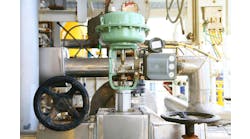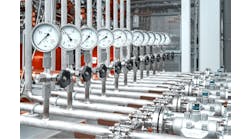| P |
urchasing a complete valve assembly, including the valve, bracket, actuator, and control accessories such as limit switches and solenoid valves, used to be quite complicated. Users had only one option. Each component had to be purchased from a different vendor, and all of the components had to be assembled and tested by someone other than the valve or component manufacturer.
Due to industry consolidation and user demand, there is now a second option: purchasing a complete valve assembly from a single vendor. There are advantages and disadvantages with each option.
With the “roll-your-own” approach, assembly and test can either be performed internally by the I&C shop or externally by a local distributor. In either case, the manufacturer of the valve or valve components is off the hook for the performance of the complete assembly.
The roll-your-own approach is obviously more complicated than the single source option, but users prefer it.
If assembly and test is performed internally, the user essentially becomes the first point of contact for all valve problems. First-level diagnostics and troubleshooting must be performed to ascertain exactly where the problem lies. Users are forced to isolate the problem to a particular component before a vendor can be contacted for a warranty claim.If assembly and test is performed by a distributor, it is often possible to get a warranty for the complete valve assembly from the distributor. The best distributors will warrant the entire valve assembly and will also offer field support. They will also pursue warranty claims with the various valve manufacturers.The roll-your-own approach is obviously more complicated than the single source option, but users prefer it for a number of reasons. Standardization for one. “Many users have standardized on a particular brand and model for a component like a switchbox or solenoid valve and may be reluctant to accept an unfamiliar substitute,” says Thomas Spock, the chief technology officer at Tyco Flow Control (www.tycovalves.com).Others buy separate components from various vendors because no single vendor makes all of the components that they need in a valve assembly. “Very few valve suppliers can supply a complete package including a high-alloy plug valve, a stainless steel actuator, a manual gear override and a Foundation fieldbus limit switch and solenoid valve,” observes Roger Barnes, the flow control division director of product development and rationalization at Flowserve (www.flowserve.com).Another reason for a user to assemble their own valves or have a distributor do assembly for them is to get the best-of-breed for each valve component. Many users believe that vendors have strengths in different areas. These valve buyers would prefer to stick with a specialist in each component area rather than a generalist valve and valve component vendor.If the valve specifier does not have requirements or preferences that preclude the purchase of a complete valve assembly from a single vendor, then this integrated valve approach has merits. “We can be a one-stop source for valve assembly and test,” according to Mike Rauber, the Fieldvue program manager for Fisher Controls (www.emersonprocess.com).“Each assembly is tested and compared to standards developed by shipping thousands of units per year. We provide a single warranty on the assembly on top of individual piece warranties. Our components are designed and optimized for each other—tuning is well known, and mountings are predesigned and tested,” adds Rauber.“An integrated control valve can often provide a more compact mechanical package. There is also the opportunity to eliminate the tubing and fittings making repair easier,” concludes Rauber.Other vendors echo Rauber’s comments. “Single source packaging can yield increased traceability of product, better repeatability and consistency of components and configurations, as well as more complete documentation such as drawings, test reports and assembly certifications,” explains Barnes.Tyco Valves provided further justification for purchasing integrated valves. “In a well-engineered integrated valve assembly, performance will be enhanced. This is especially true for modulating control valve packages where sloppy connections between the valve and the actuator can be problematic. In our recent survey we found customers are willing to pay a 510% premium for integrated valve assemblies from a recognized supplier,” says Spock.Spock’s last point raises the question of up-front and life cycle costs. End users must decide if it is worth a cost premium for an integrated valve. As with cigarettes, it is cheaper to roll your own valves. But this only accounts for the up front cost of purchasing the valve. Total life cycle costs including documentation, service, and repair must also be taken into account when deciding whether to make or buy.Dan Hebert, PE, Senior Technical Editor, [email protected]


